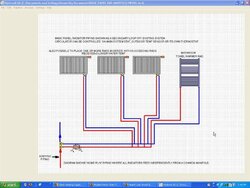And, by another coincidence, I think I met you, Heaterman, at the Mich Energy Fair in Onekema this summer at the Garn display.
Tall smiling homely guy that lives eats and breathes hydronics? That would be me
I’m still saving for my Garn (and more solar panels, better storage, etc, etc), but in the meantime I’ll definitely give you a call or stop in to get more info on the baseboard radiant panels. I have a million questions ... time to do some more reading here and then ask for some ideas/help on a new thread or two. Thanks for all the great info.
Give me a call anytime or stop in. All of the above are always good topics for discussion. Coffee is always on.
Tall smiling homely guy that lives eats and breathes hydronics? That would be me

I’m still saving for my Garn (and more solar panels, better storage, etc, etc), but in the meantime I’ll definitely give you a call or stop in to get more info on the baseboard radiant panels. I have a million questions ... time to do some more reading here and then ask for some ideas/help on a new thread or two. Thanks for all the great info.
Give me a call anytime or stop in. All of the above are always good topics for discussion. Coffee is always on.


